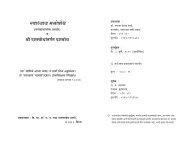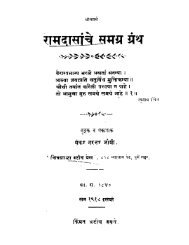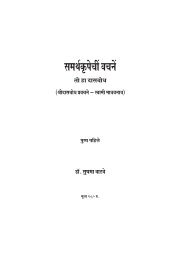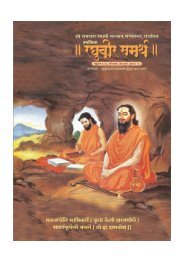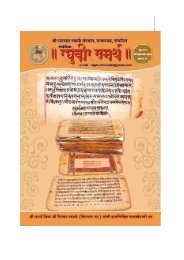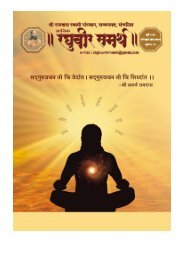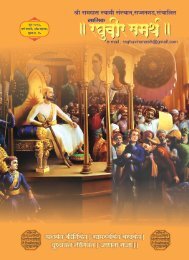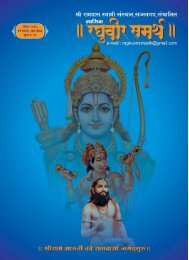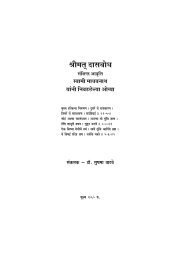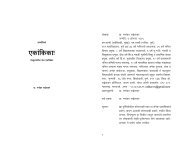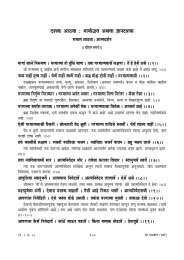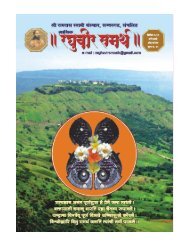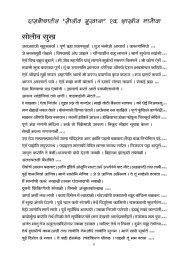You also want an ePaper? Increase the reach of your titles
YUMPU automatically turns print PDFs into web optimized ePapers that Google loves.
<strong>Way</strong> <strong>of</strong> <strong>life</strong> <strong>by</strong> <strong>Samartha</strong> <strong>Ramdas</strong><br />
In Maharashtra, the period between 12 th and 17 th century was the era <strong>of</strong><br />
the famous saints, like Dnyaneshwar, Tukaram, Eknath, Namdeo,<br />
<strong>Samartha</strong> <strong>Ramdas</strong>, and, Meerabi, Kabir etc. in North India.<br />
These saints showed common people easy path to reach God, which is<br />
called Bhaktiyog. That path was Namasmaran, which ultimately merges<br />
into transcendental meditation! The continuous ‘Namasmaran’ leads you<br />
to the state <strong>of</strong> pure consciousness. The ‘Nama’ melts into your soul<br />
gradually and your mind becomes thoughtless. The regular practice <strong>of</strong><br />
‘Namasmaran’ prepares your mind to overcome the difficult situations, in<br />
your <strong>life</strong> and gives you courage and peace <strong>of</strong> mind. Actually, peace <strong>of</strong><br />
mind is the true aim <strong>of</strong> our <strong>life</strong>. Isn’t it! That is according to <strong>Ramdas</strong>,<br />
‘Moksha’ – salvation from worldly pains.<br />
For the attainment <strong>of</strong> this kind <strong>of</strong> salvation, you need not get rid <strong>of</strong> your<br />
five senses; because the body and the mind go hand in hand. You are<br />
very well supposed to fulfill the wishes <strong>of</strong> your five senses i.e. to see,<br />
listen, smell, test, and touch. You need not lead a <strong>life</strong> <strong>of</strong> an ascetic<br />
<strong>Samartha</strong> <strong>Ramdas</strong> (1608-1682) has written approximately 40,000<br />
verses, a verse <strong>of</strong> four lines each, in different books.<br />
Karunshtake<br />
<strong>Ramdas</strong> left home when he was only twelve years old. Although he had<br />
strong control over his emotions, it was not easy to lead lonesome and<br />
hard <strong>life</strong>, during his self-training period.<br />
In that restless state <strong>of</strong> mind, <strong>Ramdas</strong> wrote Karunashtake. These are<br />
the prayers full <strong>of</strong> pathos or “Karuna rasa”. So these are called<br />
Karunshtake.<br />
<strong>Ramdas</strong> says,<br />
1
“O God keep me away from the burning flame <strong>of</strong> worldly temptations. I<br />
indeed cannot keep my mind balanced, in the state <strong>of</strong> equanimity.<br />
The <strong>life</strong> is being hard without you. Up till now, I was too much attached<br />
to my close relatives. Now, I want to learn detachment. Take me O God<br />
in your shelter. I am determined to avoid temptations and to follow the<br />
serene path which leads to you.”<br />
“I am constantly in search <strong>of</strong> happiness. But what I <strong>of</strong>ten experience is<br />
only sorrow and misery. My confused mind can neither concentrate on<br />
Meditation nor in bhajan pujan. I know that I am still running after the<br />
bodily happiness, the materialistic enjoyment and I fail to search for<br />
inner joy”.<br />
2
“While leading my lonesome <strong>life</strong> here far away from my house and<br />
family, I don’t get enough food, enough clothes. I cannot mix with the<br />
people. I feel myself like a refugee. I don’t have close relationship with<br />
anybody. I am just thrown away. O God, help me, to change my attitude<br />
and show me the right path.”<br />
3
Manache Shlok<br />
His most popular book ‘Manache Shlok or Manobodh’ includes 205<br />
schlok with 4 lines each. Since the 17 th century, ‘Manache Schlok are<br />
being recited <strong>by</strong> common people in Maharashtra. Many have learnt them<br />
<strong>by</strong> heart, since the style <strong>of</strong> schlokas is unique, easy, beautiful and<br />
simple, though artistic and meaningful.<br />
The great saint <strong>Samartha</strong> <strong>Ramdas</strong> teaches us to have dialogue with our<br />
own mind. Your own mind is your friend, your enemy and your own mind<br />
can be also your Guru.<br />
205 verses <strong>of</strong> Manache Shlok are translated into several Indian<br />
languages, including Urdu. A Muslim Saint Shahsuraj Ali has translated<br />
it into Urdu, which is called “ Manasamazavana “. His Guru was<br />
<strong>Ramdas</strong>. The handwritten copy <strong>of</strong> “Manasamzavana “still exists in the<br />
Jama Masjid <strong>of</strong> Delhi.<br />
Atmaram, Karunatake, Abhanga and Arti are his other books. All popular<br />
Marathi Artis e.g. ‘Sukhakarta Dukhhartha, Durge durghata bhari,<br />
Shivaarti, Maruti Stotra and many others are written <strong>by</strong> <strong>Ramdas</strong>.<br />
<strong>Ramdas</strong> thought, the best guide to advise the human being is his own<br />
mind.<br />
Manache Shlok teaches your mind to change yourself gradually.<br />
Find out the reasons <strong>of</strong> your anger, jealousy, greed, sorrow, depression,<br />
fear, because these are the negative emotions, which you have to face<br />
constantly in your <strong>life</strong>. Convince your mind with <strong>Ramdas</strong>’s words as he<br />
says,<br />
4
“O you, my coward mind, why are you afraid <strong>of</strong> worldly sorrows? Get rid<br />
<strong>of</strong> fear and hold courage”.<br />
Dasbodh<br />
Dasbodh is the most important book <strong>by</strong> <strong>Ramdas</strong>. The book consists <strong>of</strong><br />
7,751 verses. “Das” means servant i.e. a devotee. <strong>Ramdas</strong> was a<br />
devotee <strong>of</strong> Ram. “Bodh” means “teaching”.<br />
In ‘Dasbodh’, <strong>Ramdas</strong> touches multiple topics connected to human <strong>life</strong>.<br />
The book is a beautiful guide for the ideal human <strong>life</strong>. It teaches us how<br />
to shape our <strong>life</strong> through <strong>Ramdas</strong>’ excellent practical and spiritual<br />
principles.<br />
Dasbodh also explains multiple facets <strong>of</strong> the Universe. It really covers<br />
the whole cosmos. <strong>Ramdas</strong>, however, emphasizes the existence <strong>of</strong> God<br />
very strongly and shows common people the easy way to reach God,<br />
namely, ‘Bhaktimarg’. This, according to him, is a sure path to achieve<br />
peace <strong>of</strong> mind in <strong>life</strong>.<br />
<strong>Samartha</strong> realized that the base <strong>of</strong> a firm and healthy society is a<br />
harmonious family. One should not neglect his family. He should fulfill<br />
his duties first; otherwise, he is not fit for devoting himself to God. He<br />
says,<br />
5
“You should fulfill your duties first. Then you are only fit to think about<br />
spirituality. Make the people around you happy. The one who fulfills his<br />
duties cautiously, is able to practice spirituality; otherwise he is not<br />
supposed to be a real devotee. You <strong>life</strong> should be a good combination <strong>of</strong><br />
family <strong>life</strong> and spiritual <strong>life</strong>.”<br />
<strong>Samartha</strong> handles in “Dasbodh” varied themes, for example, family<br />
planning, health, body facts, architecture, construction <strong>of</strong> buildings,<br />
administration, politics, time management, personal development, how<br />
to train managers and leaders, management <strong>of</strong> your own mind and<br />
spiritual thoughts.<br />
6
The great souls like Gandhi, and Vivekananda had read Dasbodh and<br />
had written words <strong>of</strong> praise on “Dasbodh”.<br />
Atmaram<br />
<strong>Samartha</strong> <strong>Ramdas</strong> noticed that in spite <strong>of</strong> listening, reading and<br />
meditation, the desired expected change in the attitude <strong>of</strong> human beings<br />
was not witnessed; therefore, he guides them through the medium <strong>of</strong><br />
conversation.<br />
In “Atmaram”, <strong>Ramdas</strong> has presented a transparent fundamental<br />
thought. <strong>Samartha</strong> has guided his disciples through “Atmaram”, to<br />
practice their search for self realization. The verses in Atmaram are<br />
purely philosophical. “Atma” means soul, “Ram” means here “Supreme<br />
Being.” The idea is: an individual soul <strong>of</strong> each and every being in the<br />
universe is a part <strong>of</strong> the “Supreme Being”.<br />
Atmaram consists <strong>of</strong> 183 verses. These verses are like deep Spiritual<br />
Ocean, wherein you learn to dive and find out shells full <strong>of</strong> radiant pearls.<br />
Let us see a few verses.<br />
<strong>Ramdas</strong> explains to his disciples, “I am the supreme universe, the<br />
inspiration <strong>of</strong> energy. The same inspiration <strong>of</strong> energy is manifested in<br />
various forms in the universe. This is the awareness <strong>of</strong> equanimity and<br />
equality i.e. Atmanivedan.<br />
7
This is the state <strong>of</strong> enlightenment, which does not allow unhappiness to<br />
enter your mind. The feeling <strong>of</strong> you and me vanishes from your mind.<br />
This is called Adwait.<br />
In this era scientists have successfully tried to explore space. <strong>Samartha</strong><br />
<strong>Ramdas</strong> advises through his valuable work, to find out the space in your<br />
deep inner mind. He wants you to design your <strong>life</strong> more beautifully in an<br />
artistic way, filling it with pure happiness and peace!<br />
“To know yourself. To find out your hidden self is knowledge”<br />
8



